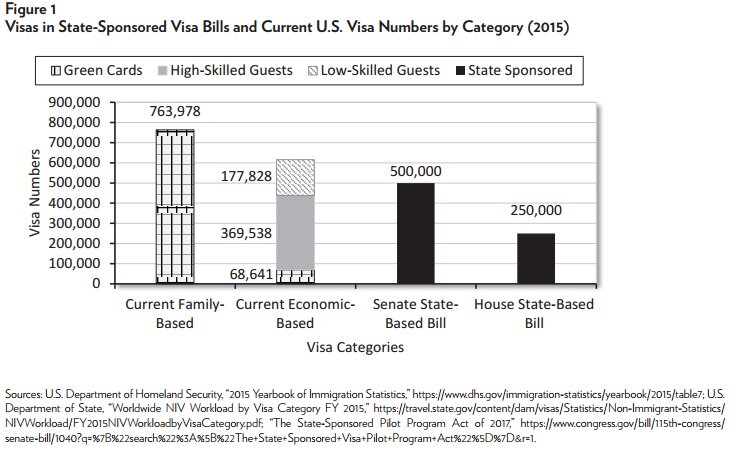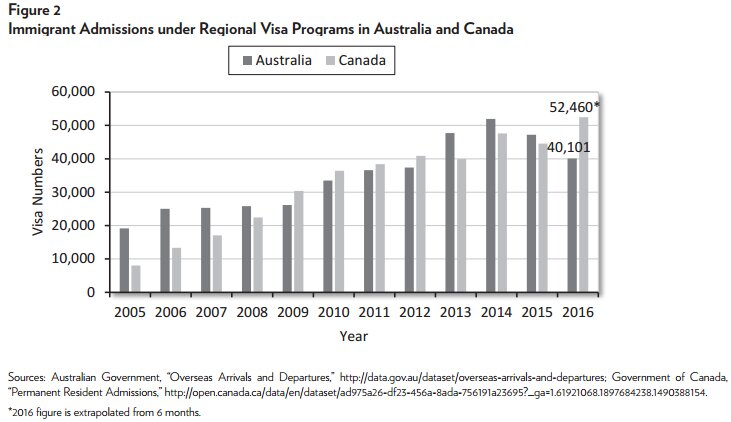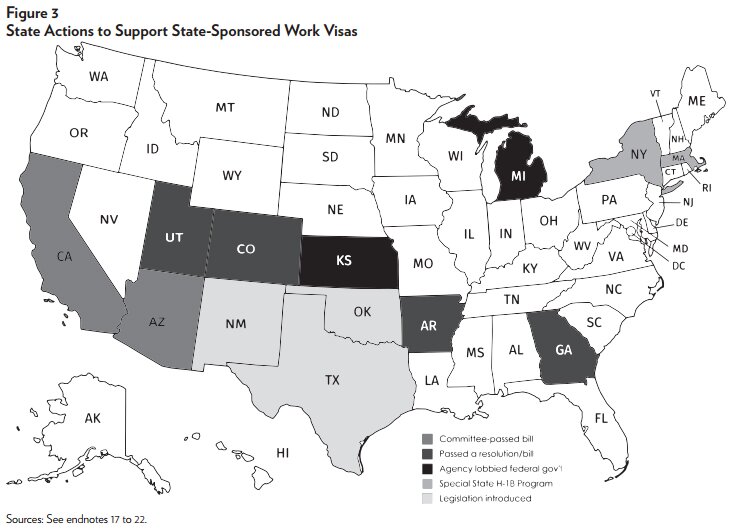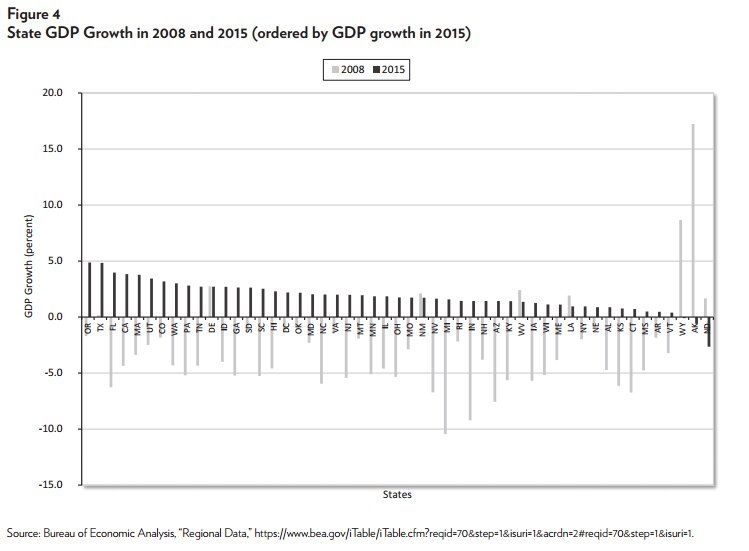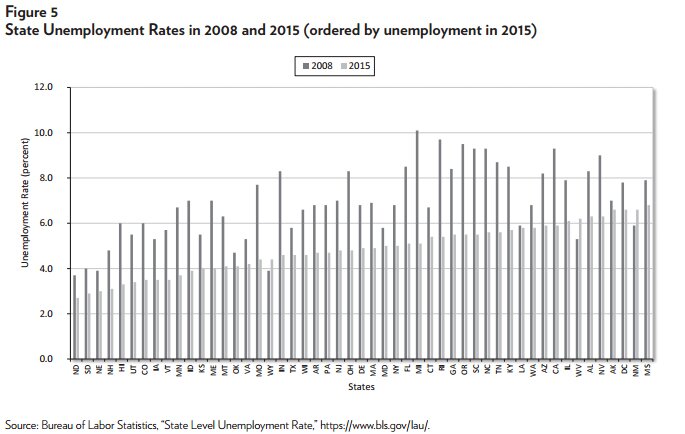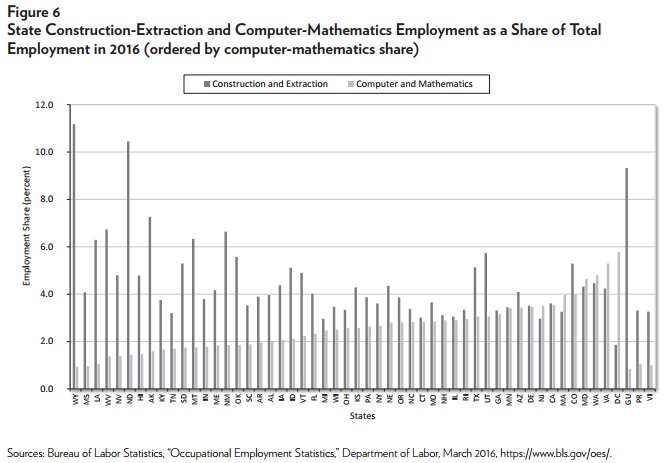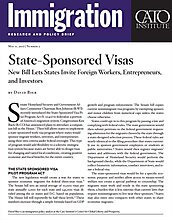Senate Homeland Security and Government Affairs Committee Chairman Ron Johnson (R‑WI) recently introduced the State-Sponsored Visa Pilot Program Act (S. 1040) to federalize a portion of America’s migration system. Congressman Ken Buck (R‑CO) has announced plans to introduce a companion bill in the House.1 Their bill allows states to implement a state-sponsored work visa program where states would sponsor migrant workers, investors, and entrepreneurs using their own criteria under federal oversight. This type of program would add flexibility to a sclerotic immigration system because states are better able to design visas for changing and varied local conditions, creating positive economic and fiscal benefits for the entire country.
THE STATE-SPONSORED VISA PILOT PROGRAM ACT
The new legislation would create a way for states to sponsor economic migrants for federal three-year visas.2 The Senate bill sets an initial average of 10,000 visas per state annually: 5,000 for each state and 245,000 visas divided among the 50 states and D.C. based on population. The House bill will reportedly be half these levels.3 These numbers increase through a simple formula based on GDP growth and program enforcement. The Senate bill copies current nonimmigrant visa programs by exempting spouses and minor children from numerical caps unless the states choose otherwise. States could opt in to this program by passing a law and complying with federal rules. The state government would then submit petitions to the federal government requesting admission for the migrants chosen by the state through a state-designed selection process. These federal rules are nearly identical to the filing procedure that states currently use to sponsor government employees or students at public universities.4
States would then register migrants' names and addresses with the federal government. The Department of Homeland Security would perform the background checks, while the Department of State would collect biometric information, conduct interviews, and issue a federal visa.
The state-sponsored visas would be for a specific economic purpose and neither allow access to means-tested welfare nor create a special pathway to citizenship. The migrants must work and reside in the state sponsoring them, a burden that is less onerous than current laws that require nonimmigrants to live near their sponsors.5 States may also enter into compacts with other states to share economic migrants.
The bill incentivizes migrants to comply with the visa rules. State-sponsored migrants may only renew their visas if they are residing and working in the state that sponsors them. Current temporary worker programs incentivize compliance in a similar manner, forbidding workers who overstay their visas or those who work illegally from reapplying or extending their status. This incentive has kept their overstay rates below 3 percent.6 The bill also attempts to guarantee that the new program maintains this level of compliance. If more than 3 percent of a state’s sponsored migrants are illegally working or residing in a state other than the one that sponsored them, future statesponsored migrants to that state must pay a $4,000 bond that is returned only after they leave the United States. Both of these provisions are powerful incentives for state-sponsored migrants to comply with the rules.
States also have incentives to guarantee migrant compliance. The bill provides that non-compliant migrants will be deported at state expense, and those states that refuse to pay will be unable to sponsor new migrants. Additionally, a state’s allocation of visas would fall by 50 percent if more than 3 percent of their sponsored migrants reside or work in another state. If the abscond rate is above 3 percent for three consecutive years, then the state will be barred from sponsoring new migrants for five years. As a positive incentive, a state’s numerical cap rises by 10 percent for each year that less than 3 percent of the state-sponsored migrants work illegally. This carrot-stick approach provides a strong incentive for states to ensure migrant compliance with the rules.
HOW THE BILL WILL IMPACT U.S. IMMIGRATION
America’s current system heavily restricts employmentbased migration, focusing instead on family connections. The proposed legislation would help level the playing field, making it easier for foreigners to enter the country based on economic factors, without making it more difficult for families to reunite. The bill’s only requirement is that the worker enters “to perform services, provide capital investment, direct the operations of an enterprise, or otherwise contribute to the economic development agenda of the State.”7 This language gives states the latitude to invite workers of any skill level or provide a pathway for investors or entrepreneurs.
If all states participated and all visas were used, the Senate bill would increase the annual flow of economic migrants by up to 81.2 percent.8 Based on the reported quota in the House bill, it would increase the annual flow of economic migrants by up to 40.6 percent. Figure 1 presents the annual flow for family-based immigrants and the various categories of economic-based workers compared to the proposed increases from each bill. States would also be able to create new economic visas for entrepreneurs, investors, and other types of economic migrants.
The bill would also allow states with smaller populations to attract more migrants. Large employers in populous states have an advantage in the current system. Even though 30 percent of the U.S. population lives in the 34 smallest states, only 16 percent of all immigrants do.9 The legislation helps to level that playing field by guaranteeing every state access to a certain share of the visas issued every year. Because the workers would be required to live in the state sponsoring them, the bill would make it easier for less populous regions to retain their workers as well.
SUCCESSFUL REGIONAL MIGRATION SYSTEMS IN OTHER COUNTRIES
Canada and Australia have large regional visa systems similar to that proposed by the State-Sponsored Visa Pilot Program Act.10 The Canadian Provincial Nominee Program allows provinces to nominate immigrants for permanent residency. A 2011 review of the program by Canada's federal immigration department concluded that the program was a success and regionalized the benefits of immigration.11 About 90 percent of all provincial nominees were employed or self-employed within one year, and almost 80 percent remained in the province for three years, even though there was no long-term residency requirement. 12 The 52,460 nominees were 16.3 percent of all immigrants to Canada in 2016.13
Australia has four regional residency visas.14Altogether, those regions issued 40,101 visas during the 2015–2016 year, representing 31.2 percent of the skills-based immigration to Australia.15 A 2004 Australian survey of one of these programs found that 91 percent of primary applicants were living in the region that originally sponsored them, despite no requirement to do so; that their unemployment rate was less than 1 percent; and that both employers and immigrants were pleased.16 The growing demand for these visas demonstrates their increasing popularity. Canada's Provincial Nominee Program grew fivefold from 2005 to 2016, while Australia's regional visa programs doubled (Figure 2).17
CURRENT STATE INVOLVEMENT IN IMMIGRATION
States have the experience and desire to manage statesponsored migration programs. American states already coordinate with the federal government on immigration enforcement and Congress can constitutionally delegate some of its migration powers to states.18 States currently help determine “targeted employment areas” for the EB-5 investor visa. For the physician visa program, state public health departments can sponsor doctors to serve in medically underserved areas. States also directly sponsor foreign students and state employees in their capacity as universities and employers.19
States clearly wish to go further (Figure 3). Federal law has no provision for foreign entrepreneurs, so several states have taken advantage of the special treatment that universities receive to allow them to stay in the United States. The law exempts foreign professors from the H-1B high-skilled visa quota, so state institutions in New York, Massachusetts, and Colorado have created programs whereby the university sponsors the entrepreneurs as professors, but allows them to spend most of their time building their businesses.20
The Colorado and Utah legislatures both passed laws to create state-level migration programs, but neither have received federal permission to begin recruitment.21 Utah’s laws go even further by also creating state-sponsored immigration and legalization programs.22 Elected officials and legislatures in Arkansas, Kansas, Georgia, and Michigan have passed resolutions or lobbied Congress for permission to create their own migration programs.23 In the last decade, the workforce committee of the Arizona legislature passed a state-sponsored guest worker program, and the California State Assembly passed a legalization program for agricultural workers.24 State representatives in Texas, New Mexico, and Oklahoma have also introduced legislation to create state-sponsored visa programs.25
THE ECONOMIC LOGIC OF STATE-SPONSORED VISAS
The federal government has a monopoly over both the number of foreign workers and the type of workers who enter the United States, yet this one-size-fits-all approach is ill equipped to address the diverse needs of the states. It is simply an impossible task for Congress to determine the economic demands in every corner of the country. In 2015, for example, national GDP grew 2.5 percent, but the top 10 GDP growth states grew an average of 3.6 percentage points more than the worst-performing 10 (Figure 4).26 Recessions expand these differences. In 2008, the difference between the top and bottom 10 states was a mammoth 10.5 percentage points.
Unemployment rates also vary considerably across states, and recessions have a similar effect (Figure 5). In 2015, the 10 states with the highest unemployment rates had an average rate (6 percent) double that of the 10 states with the lowest unemployment rates (3 percent).27 Back in 2008, this difference was 5.5 percentage points.28 In 2009, Congress ignored these variations and focused instead on creating jobs in the majority of depressed states.29 The new administration actually adopted restrictions on work visas nationwide.30
The federal government fares no better at calculating the types of workers that each state requires. Employment by sector differs dramatically across states, especially in those where immigrants are most likely to work.31 Agricultural and tech occupations, where immigrants are twice as likely to be employed as natives, highlight this issue well (Figure 6).32 The location with the highest share of computer and mathematics employment (D.C.) had a share six times greater than the location with the lowest share (Wyoming) in 2015. The exact opposite was true in the construction and extraction field that year. A similar pattern plays out for the other 21 Bureau of Labor Statistics major occupational categories.
Congress has also shown itself very slow to respond to shifts in the labor market in states. Manufacturing fell from being the leading industry of employment in 36 states in 1990 to just 16 states in 2016. Health care was not the leading industry in any state in 1990, but by 2015, it was the top industry in 33 states.33 Unauthorized immigrants shifted their employment, too. In 1990, Congress left the H-2A seasonal farm worker program uncapped because most undocumented workers performed agricultural work. Yet by 2014, U.S. agricultural employment had halved, and 83 percent of unauthorized workers were performing year-round labor in other industries.34
Despite these changes, Congress has made no major reforms to the immigration system—no temporary worker visa for year-round, lower-skilled jobs, and barely any increase in the high-skilled worker programs. The State-Sponsored Visa Pilot Program Act would allow states to keep up with these changes by fine-tuning their own migration programs. States would fix problems before they became a major national crisis.
THE FISCAL IMPACT OF THE STATESPONSORED VISA PILOT PROGRAM ACT
The federal government would have no direct costs under the program because it requires states to cover any administrative costs through visa processing fees (which they could pass on to the applicants or employers). The migrants themselves are barred from all forms of federal benefits. The National Academy of Sciences 2016 report on the economic and fiscal effects of immigration found that immigrants, in general, have a positive impact on the economy, the income of most American workers, and on most government budgets.35
Using a simple model developed by Thomas V. Church at the Hoover Institution, a state-sponsored migrant who is similar to the average migrant worker today and who works for three years and then returns to his home country will pay $12,186 more in federal taxes than he and his family will receive in federal benefits.36 If the worker stays for five years, then he will pay $20,577 more in federal taxes than he will receive in benefits under the same assumptions.37 Over the first decade of the program, all new migrants who enter on the state-sponsored migration program and work for three years will pay $105.3 billion more in federal taxes than they will receive in federal benefits. The total estimated federal net-fiscal benefit rises to an estimated $150.7 billion if the migrants work for five years before returning to their home countries.
CONCLUSION
The State-Sponsored Visa Pilot Program Act would improve the migration system by allowing states to design economic migration programs suited to their own particular, varied, and unique circumstances. The legislation will more fairly distribute immigrants throughout the United States, giving less populous areas a fair shot at attracting people to their states. Because state-sponsored migrants will not have access to federal benefits, they will pay far more in federal taxes than they will receive in benefits.
Regional immigration systems have succeeded in other countries, and this approach accords with America’s long tradition of federalism in almost every other policy area. The states already have experience in managing portions of the current immigration system, and many have expressed their desire to manage their own work visa programs in the recent past. With the knowledge that each area has input into the program, this individualized approach has the potential to increase support for immigration across the country, allowing America to set aside harmful protectionism and move closer to an economically competitive system.
NOTES
1. Comments of Congressman Ken Buck, “State-Based Visas: A Federalism Approach to the Immigration Impasse,” Cato Institute Capitol Hill Briefing, May 3, 2017, 35:02, https://www.cato. org/events/state-based-visas-federalism-approach-immigrationimpasse.
2. “S.1040 - A Bill to Amend the Immigration and Nationality Act to Provide for a State-sponsored Nonimmigrant Pilot Program, and for Other Purposes,” https://www.congress.gov/ bill/115th-congress/senate-bill/1040?q=%7B%22search%22%3 A%5B%22The+State+Sponsored+Visa+Pilot+Program+Act%22 %5D%7D&r=1. Text released originally here: “State-Sponsored Visa Pilot Program Act of 2017,” https://www.ronjohnson. senate.gov/public/_cache/files/a7f53906-90eb-4d3d-abd0- 8964fc23bdbb/170503-rhj-signed-state-sponsored-visapilot-program-act-002-.pdf.
3. Comments of Senator Ron Johnson, “State-Based Visas: A Federalism Approach to the Immigration Impasse,” Cato Institute 8 Capitol Hill Briefing, May 3, 2017, 29:35, https://www.cato.org/ events/state-based-visas-federalism-approach-immigrationimpasse.
4. Title 8, Section 214.2(h)(2) of the Code of Federal Regulations, https://www.uscis.gov/ilink/docView/SLB/HTML/SLB/0-0-0- 1/0-0-0-11261/0-0-0-17197/0-0-0-18003.html.
5. Title 8, Section 214 of the Code of Federal Regulations, “Nonimmigrant Classes,” https://www.gpo.gov/fdsys/pkg/CFR- 2001-title8-vol1/pdf/CFR-2001-title8-vol1-part214.pdf.
6. David Bier, “Do Guest Workers Overstay? Not Often,” Niskanen Center, March 12, 2015, https://niskanencenter.org/ blog/do-guest-workers-overstay-not-often/.
7. “S.1040 - A Bill to Amend the Immigration and Nationality Act to Provide for a State-sponsored Nonimmigrant Pilot Program, and for Other Purposes,” https://www.congress.gov/bill/115thcongress/senate-bill/1040?q=%7B%22search%22%3A%5B%22st ate+sponsored+visa+pilot%22%5D%7D&r=2.
8. Office of Immigration Statistics, “2015 Yearbook of Immigration Statistics,” Department of Homeland Security, https:// www.dhs.gov/immigration-statistics/yearbook/2015/table7; and “Worldwide NIV Workload by Visa Category FY 2015,” Department of State, https://travel.state.gov/content/dam/ visas/Statistics/Non-Immigrant-Statistics/NIVWorkload/ FY2015NIVWorkloadbyVisaCategory.pdf.
9. Migration Policy Institute, “Immigrant Population by State, 1990-Present,” http://www.migrationpolicy.org/programs/datahub/charts/immigrant-population-state-1990-present?width=1 000&height=850&iframe=true.
10. Brandon Fuller and Sean Rust, “State-Based Visas: A Federalist Approach to Reforming U.S. Immigration Policy,” Cato Institute Policy Analysis no. 748, April 23, 2014, https://object.cato.org/ sites/cato.org/files/pubs/pdf/pa748_web_1.pdf.
11. Citizenship and Immigration Canada, “Evaluation of the Provincial Nominee Program,” Research and Evaluation no. ER201110.01E (September 2011), http://www.cic.gc.ca/english/ pdf/research-stats/evaluation-pnp2011.pdf.
12. Ibid.
13. Government of Canada, “Facts & Figures 2015: Immigration Overview—Permanent Residents,” http://open.canada.ca/data/ en/dataset/2fbb56bd-eae7-4582-af7d-a197d185fc93.
14. Fuller and Rust, “State-Based Visas/”; Department of Immigration and Border Protection, “Business Innovation and Investment (Provisional) Visa (subclass 188),” Australian Government, https://www.border.gov.au/Trav/Visa-1/188-; Department of Immigration and Border Protection, “Regional Sponsored Migration Scheme Visa (subclass 187),” Australian Government, https://www.border.gov.au/Trav/Visa-1/187-; Department of Immigration and Border Protection, “Skilled Nominated Visa (subclass 190),” Australian Government, https://www.border.gov.au/Trav/ Visa-1/190-; Department of Immigration and Border Protection, “Skilled Regional (Provisional) Visa (subclass 489),” Australian Government, https://www.border.gov.au/Trav/Visa-1/489-; and Australian Visa Bureau, “Australian State Sponsored Visa: Skilled—Nominated (Provisional) Visa (subclass 489),” http://www.visabureau.com/australia/regional-sponsored-visa.aspx.
15. Department of Immigration and Border Protection, “2015-2016 Migration Programme Report,” Australian Government, June 30, 2016, p. 11, https://www.border.gov.au/ReportsandPublications/ Documents/statistics/2015-16-migration-programme-report.pdf.
16. Roslyn Cameron, “Responding to Australia’s Regional Skill Shortages through Regional Skilled Migration,” Journal of Economic and Social Policy 14, no. 3 (2011): 4, http://epubs.scu.edu.au/ cgi/viewcontent.cgi?article=1163&context=jesp.
17. Government of Canada, “Permanent Resident Admissions,” http://open.canada.ca/data/en/dataset/ad975a26-df23-456a-8ada- 756191a23695?_ga=1.61921068.1897684238.1490388154; and Australian Government, “Overseas Arrivals and Departures,” http:// data.gov.au/dataset/overseas-arrivals-and-departures.
18. “Congress specifically preserved such authority for the States.” See Chamber of Commerce v. Whiting, 563 U.S. 582 (2011), https://www.law.cornell.edu/supct/pdf/09-115P.ZO.
19. “Policy Memorandum,” United States Citizenship and Immigration Services, May 30, 2013, https://www.uscis.gov/sites/ default/files/USCIS/Laws/Memoranda/2013/May/EB-5%20 Adjudications%20PM%20%28Approved%20as%20final%20 5-30-13%29.pdf; “Conrad 30 Waiver Program,” U.S. Citizenship and Immigration Services, https://www.uscis.gov/workingunited-states/students-and-exchange-visitors/conrad-30-waiverprogram; Mark Spivey, “Report: Rural Health a Target for Harm by Trump Travel Ban,” RAC Monitor, February 8, 2017, https:// 9 www.racmonitor.com/report-rural-health-a-target-for-harm-bytrump-travel-ban; and “About Sevis,” Department of Homeland Security, 2017: https://studyinthestates.dhs.gov/sevis-help-hub/ about-sevis.
20. Liz Robbins, “CUNY Schools to Lure Foreign Entrepreneurs With New Visa Program,” New York Times, February 17, 2016, https://www.nytimes.com/2016/02/18/nyregion/cuny-schools-tolure-foreign-entrepreneurs-with-new-visa-program.html?_r=0; “The Global Entrepreneur in Residence (GEIR) Program,” Massachusetts Technology Collaborative, http://masstech. org/innovation-institute/projects-and-initiatives/globalentrepreneur-residence-pilot-program; and “Global Entrepreneurs in Residence Program,” University of Colorado Boulder, http://www.colorado.edu/entrepreneurship/sites/default/files/ attached-files/global_eir_flyer_v2.0.pdf.
21. “State Laws Related to Immigrants and Immigration,” National Conference of State Legislatures, July 24, 2008, http://www.ncsl.org/print/immig/immigreportjuly2008.pdf; and Kirk Siegler, “Three Years On, Utah’s Immigrant Guest Worker Law Still Stalled,” NPR, July 31, 2014, http://www.npr. org/2014/07/31/336848634/three-years-on-utahs-immigrantguest-worker-law-still-stalled.
22. Senate Joint Resolution 12 (2011), http://le.utah.gov/~2011/ bills/static/SJR012.html; House Bill 469 (2011), http://le.utah. gov/~2011/bills/static/HB0469.html; House Bill 466 (2011), http:// le.utah.gov/~2011/bills/static/HB0466.html; and House Bill 116 (2011), http://le.utah.gov/~2011/bills/static/HB0116.html.
23. “2007 Enacted State Legislation Related to Immigrants and Immigration,” National Conference of State Legislatures, January 31, 2008, http://www.ncsl.org/Portals/1/documents/ immig/2007Immigrationfinal.pdf; “Kansas Seeks Waiver for Undocumented Workers to Solve Farm Crisis,” Fox News, January 30, 2012, http://www.foxnews.com/politics/2012/01/30/kansas-seekswaiver-for-undocumented-workers-to-solve-farm-crisis.html; Senate Resolution 715 (2011), http://www.legis.ga.gov/Legislation/ en-US/display/20112012/SR/715; and Monica Davey, “Immigrants Seen as Way to Refill Detroit Ranks,” New York Times, January 23, 2014, https://www.nytimes.com/2014/01/24/us/immigrants-seenas-way-to-refill-detroit-ranks.html.
24. Jon Johnson, “Konopnicki’s Guest Worker Bill Passes Committee,” Eastern Arizona Courier, February 20, 2008, http://www.eacourier.com/news/konopnicki-s-guest-workerbill-passes-committee/article_6413478f-7a0f-5332-b66b- 0308af5c3e3b.html; and Alex Nowrasteh, “Immigration Reform: Let the States Lead the Way,” Los Angeles Times, June 16, 2015, http://www.latimes.com/nation/la-oe-nowratseh-let-states-issueguest-worker-visas-20150613-story.html.
25. "Oklahoma State Senator Plans to Propose Guest Worker Program Bill," News 6, December 14, 2012, http://www.news9.com/story/20350803/oklahoma-state-senator-proposes-guestworker-program; H.B. No. 3735, http://www.capitol.state.tx.us/tlodocs/84R/billtext/pdf/HB03735I.pdf#navpanes=0; and New Mexico Senate Bill 14 (2012), https://legiscan.com/NM/bill/SB14/2012.
26. Bureau of Economic Analysis, “Regional Data,” https://www. bea.gov/iTable/iTable.cfm?reqid=70&step=1&isuri=1&acrdn=2#r eqid=70&step=1&isuri=1.
27. Bureau of Labor Statistics, “State Level Unemployment Rate,” https://www.bls.gov/lau/.
28. Ibid.
29. David Rogers, “Senate Passes $787 Billion Stimulus Bill,” Politico, February 13, 2009, http://www.politico.com/story/2009/02/ senate-passes-787-billion-stimulus-bill-018837.
30. American Farm Bureau Federation, “Statement by Bob Stallman, President, American Farm Bureau Federation, Regarding Final H2A Rule,” February 12, 2010, http://immigrationworksusa. org/uploaded/file/AFBF_statement.pdf.
31. Bureau of Labor Statistics, “Occupational Employment Statistics,” Department of Labor, March 2016, https://www.bls. gov/oes/.
32. Bureau of Labor Statistics, “Foreign-Born Workers: Labor Force Characteristics—2015,” U.S. Department of Labor, May 19, 2016, https://www.bls.gov/news.release/pdf/forbrn.pdf.
33. Bureau of Labor Statistics, “Major Industries with Highest Employment, by State, 1990–2015,” Department of Labor, August 5, 2016, https://www.bls.gov/opub/ted/2016/major-industries-withhighest-employment-by-state.htm.
34. Jeffrey Passel and D’Vera Cohn, “Share of Unauthorized Immigrant Workforce Stable after Great Recession,” Pew Research Center, November 3, 2016, http://www.pewhispanic. org/2016/11/03/industries-of-unauthorized-immigrant- 10 workers/; and Bureau of Labor Statistics, “Foreign-Born Workers: Labor Force Characteristics—2015,” U.S. Department of Labor, May 19, 2016, https://www.bls.gov/news.release/pdf/ forbrn.pdf.
35. See Francine Blau and Christopher Mackie, “The Economic and Fiscal Consequences of Immigration,” National Academies of Sciences, Engineering, and Medicine, September 22, 2016, https://www.nap.edu/catalog/23550/the-economic-and-fiscalconsequences-of-immigration.
36. The economic and demographic assumptions are that the new state-sponsored migrants will earn $45,177 (equal to the current average for working immigrants); their incomes will increase by 1 percent per year; 95 percent of the state-sponsored migrants will work; the migrants will pay 11.7 percent in federal income, excise, business, and social insurance taxes as estimated by the Joint Committee on Taxation; they will not have access to means-tested welfare or the Earned Income Tax Credit (EITC) as per the requirements of the State-Sponsored Visa Pilot Program Act; they will each have 1.13 children, on average, who attend public schools at a constant federal marginal cost; the state-sponsored migration program cap is met every year; average annual national GDP growth is 1.5 percent; and the numerical cap increases annually by 10 percent due to perfect compliance.
37. Thomas V. Church, “Estimating the Economic and Budgetary Effects of New H-1B Visas in the Senate Gang of Eight’s Proposed Immigration Bill,” Hoover Institution, May 7, 2013, http://www.hoover.org/sites/default/files/uploads/aafs/2013/05/Estimating-the-Economic-and-Budgetary-Effects-of-H-1B-Reform-In-S.744.pdf.
RELATED PUBLICATIONS FROM THE CATO INSTITUTE
Criminal Immigrants: Their Numbers, Demographics, and Countries of Origin by Michelangelo Landgrave and Alex Nowrasteh, Cato Institute Immigration Research and Policy Brief no. 1 (March 15, 2017).
Immigrants Assimilate into the Political Mainstream by Alex Nowrasteh and Sam Wilson, Cato Institute Economic Development Bulletin no. 27 (January 19, 2017).
Terrorism and Immigration: A Risk Analysis by Alex Nowrasteh, Cato Institute Policy Analysis no. 798 (September 13, 2016).
The Fiscal Impact of Immigration by Alex Nowrasteh, Cato Institute Working Paper no. 21 (July 23, 2014).
Does Immigration Impact Institutions? by J. R. Clark, Robert A. Lawson, Alex Nowrasteh, Benjamin Powell, and Ryan Murphy, Cato Institute Working Paper no. 19 (May 6, 2014).
State-Based Visas: A Federalist Approach to Reforming U.S. Immigration Policy by Brandon Fuller and Sean Rust, Cato Institute Policy Analysis no. 748 (April 23, 2014).
The Economic Gains from Eliminating U.S. Travel Visas by Robert A. Lawson, Saurav Roychoudhury, and Ryan Murphy, Cato Institute Economic Development Bulletin no. 19 (February 6, 2014).
The Political Externalities of Immigration: Evidence from the United States by Zachary Gochenour and Alex Nowrasteh, Cato Institute Working Paper no. 14 (January 15, 2014).
